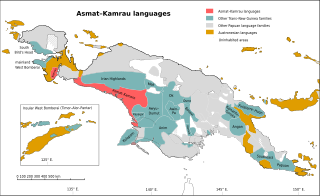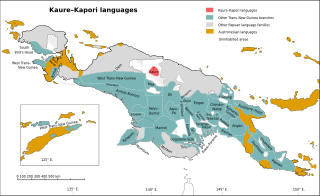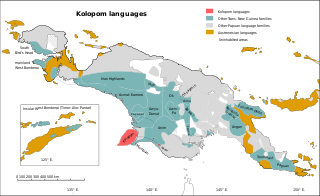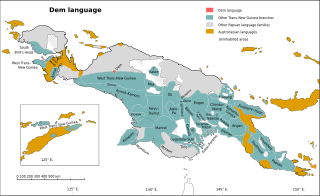Related Research Articles
Elseng is a poorly documented Papuan language spoken by about 300 people in the Indonesian province of Papua. It is also known as Morwap, which means "what is it?" ‘Morwap’ is vigorously rejected as a language name by speakers and government officials.

The Asmat – Kamrau Bay languages are a family of a dozen Trans–New Guinea languages spoken by the Asmat and related peoples in southern Western New Guinea. They are believed to be a recent expansion along the south coast, as they are all closely related, and there is little differentiation in their pronouns.

The Kayagar languages are a small family of four closely related Trans–New Guinea languages spoken around the Cook River in Province of South Papua, Indonesia:

The Kaure–Kosare or Nawa River languages are a small family spoken along the Nawa River in West Papua, near the northern border with Papua New Guinea. The languages are Kaure and Kosare.

The Mombum languages, also known as the Komolom or Muli Strait languages, are a pair of Trans–New Guinea languages, Mombum (Komolom) and Koneraw, spoken on Komolom Island just off Yos Sudarso Island, and on the southern coast of Yos Sudarso Island, respectively, on the southern coast of New Guinea. Komolom Island is at the southern end of the Muli Strait.

The East Strickland or Strickland River languages are a family of Papuan languages.
Momuna (Momina), also known as Somahai, is a Papuan language spoken in Yahukimo Regency, Highland Papua and Asmat Regency, South Papua, Indonesia.

The Finisterre–Huon languages comprise the largest family within the Trans–New Guinea languages (TNG) in the classification of Malcolm Ross. They were part of the original TNG proposal, and William A. Foley considers their TNG identity to be established. The languages share a small closed class of verbs taking pronominal object prefixes some of which are cognate, strong morphological evidence that they are related.

The Kolopom languages are a family of Trans–New Guinea languages in the classifications of Stephen Wurm (1975) and of Malcolm Ross (2005). Along with the Mombum languages, they are the languages spoken on Kolepom Island in South Papua, Indonesia.
The Demta–Sentani languages form a language family of coastal Indonesian Papua near the Papua New Guinea border.

The Yam languages, also known as the Morehead River languages, are a family of Papuan languages. They include many of the languages south and west of the Fly River in Papua New Guinea and Indonesian Western New Guinea.

The Palei languages constitute a branch of the Torricelli language family according to Laycock (1975). They are spoken in mountainous regions of eastern Sandaun Province, Papua New Guinea.

Dem is a divergent Papuan language of West New Guinea. Although Palmer (2018) leaves it unclassified, it was tentatively included in the Trans–New Guinea family in the classification of Malcolm Ross (2005), and Timothy Usher ties it most closely to Amung.

Mor is a nearly extinct Trans–New Guinea language of Indonesia. It is spoken along the Budidi River and the Bomberai River on the Bomberai Peninsula.
Kapori (Kapauri) is a Papuan language of Pagai village in Airu District, Jayapura Regency, Papua, Indonesia.

Sumuri or Sumeri is a language spoken in Sumuri District, Teluk Bintuni Regency on the Bomberai Peninsula by about a thousand people.
Molof is a poorly documented Papuan language spoken by about 200 people in Molof village, Senggi District, Keerom Regency.
Tofanma or Tofamna is a poorly documented Papuan language of Indonesia. Wurm (1975) placed it as an independent branch of Trans–New Guinea, but Ross (2005) could not find enough evidence to classify it. It appears to be related to Namla, a neighboring language.

The Boazi languages, also known as the Lake Murray languages, are a pair of languages in the Trans–New Guinea family, spoken near Lake Murray. They were previously classified in the Marind branch.
The East Pauwasi languages are a family of Papuan languages spoken in north-central New Guinea, on both sides of the Indonesia-Papua New Guinea border. They may either form part of a larger Pauwasi language family along with the Western Pauwasi languages, or they could form an independent language family.
References
- 1 2 3 "76336553". viaf.org. Retrieved 2020-01-15.
- 1 2 3 4 "Biographical notes" (PDF). Archived from the original (PDF) on 2020-03-22. Retrieved 2020-03-22.
- ↑ "Voorhoeve, Clemens Lambertus - Archives". archivescollection.anu.edu.au. Retrieved 2020-01-15.